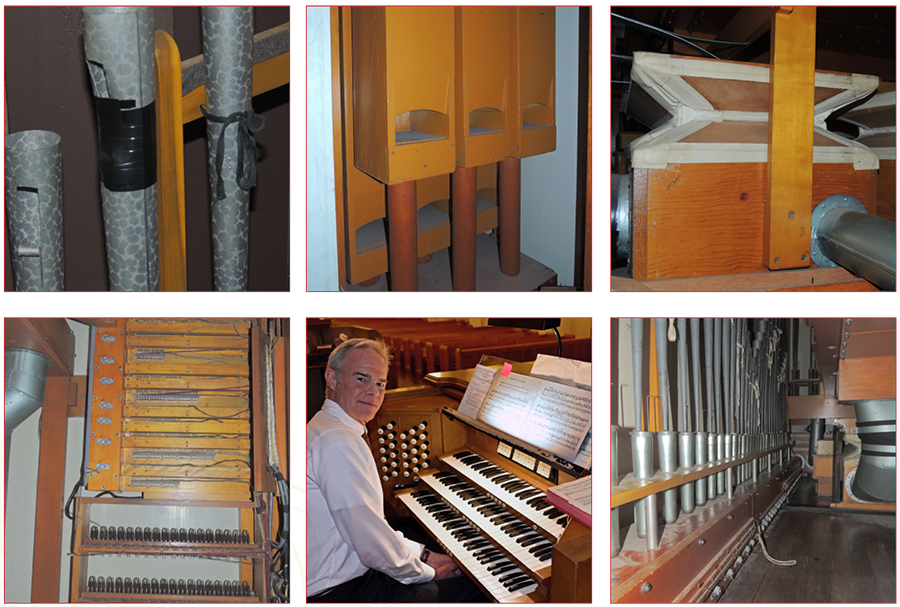Our Needs
It is time to replace our beloved pipe organ. It is mechanically failing and is no longer reasonably repairable. Issues with the current organ and options considered are detailed below.
- Organ pipes: made of soft metal and wood, the pipes are worn from use, age, climate conditions, and tuning.
- Valve controls: made of leather, the valve controls are dried out, brittle, and torn. This can allow air leaks into the pipe, causing it to cipher, or make a sound without having the appropriate key depressed. This happened on Ash Wednesday, which interrupted the worship service and rendered the organ unusable the following weekend.
- Relays: many of our pipe relays, or circuits, are broken, so the pipe can’t make a sound. Our organ’s electro-pneumatic technology is outdated from today’s solid state circuitry.
- Water Damage: water has damaged the wind chests in the chambers and the wood “boxes” that hold the pipes. Though repaired, repeated water damage has accelerated the aging of the chests and other materials.
- Volume Control: the expression shades, which control the organ’s volume, use motors and bellows to open and close. Because they were improperly rebuilt in 1975, they are blowing apart.
- Console: full of components and wiring, the console will soon be in complete failure. Leaking switches cause sluggish, unreliable action, and louder than normal noises. Repairs can no longer be done as they only further weaken older parts and other new points begin leaking.
- Maintenance and Repairs: air conditioning blowing on the pipes causes them to go immediately out of tune. Tuning causes more wear and tear, and expensive maintenance has become a matter of judiciously doing only what must be done to keep the organ operational while major repair issues escalate.
Organ Committee
2013
An Organ Committee, under Pastor Ken Dunnington, was formed to assess our organ’s condition, research options, and make a recommendation to the church.
2014
Organ curators completed an organ mechanical and tonal assessment and the Organ Committee extensively researched restoration, renovation, and buying a new organ; investigated the pros and cons of digital organs and the incorporation of digital technology within a pipe organ; visited many churches with pipe organs, and met with organ builders. Their findings are summarized here.
Organ Upgrades And Needs
- Proper support for choral singing requires more volume stops than our current organ.
- It is important to have the ability to perform, in concert, a wide range of organ repertoire including preludes, offertories and postludes, worship hymn accompaniment, and all musical genres from baroque to romantic to contemporary.
- A moveable console offers the most flexibility for both worship services and concerts.
- A pipe organ must have longevity, making sure that this one-of-a-kind instrument is available and able to serve future generations.
- Our organ should be a visually beautiful instrument in keeping with Calvary’s Neo-Gothic architecture.
Current Organ Issues and Considerations
- Tonal Issues: our present organ’s narrowly scaled pipes and lack of solo stops hamper our ability to lead and support the congregation, and to fully render organ music to its most beautiful and creative potential. These tonal issues cannot be adequately remedied through re-voicing efforts on our current organ.
- Considering Renovation: the 1953 and 1975 renovations of our organ resulted in messy, inefficient pipe placement. This has resulted in tuning being required more often, prevented proper servicing, and created stability issues.
- Considering Repair: mechanically there are three major considerations: improperly rebuilt expression shades have resulted in the motors destroying themselves; failing relays are not cost effective to rebuild, and all mechanical renovations would employ outdated technology.
- Considering Replacement: repair and renovation estimates were, at minimum, about 50-60 percent the cost of an all new pipe organ and still would not fix all the identified problems. Organ builders, technicians, and musicians were unanimous that a renovation and repair would likely yield a less-than-satisfactory outcome.
- Conclusion: repairing or renovating our present organ would not be the best option for Calvary.
Digital Organ Research
- Recorded Sound: digital organs are essentially live organ recordings put through complicated digital technology to try to replicate pipe sounds.
- Short Life Span: digital organ electronics and quickly changing technology result in an estimated 20 year life span compared to the estimated 100+ years of a pipe organ.
- Cost: depending on size and quality, the costs of digital organs range from $150,000 to over $1 million. Even if costs are initially lower than for other types of organs, over the long-term the church could spend more replacing a digital organ approximately every 20 years.
- Speakers: from 20 to 60 speakers would be required, depending on organ size and quality. Speakers not placed in the present pipe chambers would be positioned throughout the sanctuary, balcony and possibly the transepts to achieve the same fullness of sound provided by a pipe organ. This would not have the visual aesthetic we desire for our Neo-Gothic sanctuary.
- Digital/Pipe Hybrid: a hybrid organ (say 50% digital/50% pipe) would demand more frequent maintenance costs and overhaul needs.
- Conclusion: though a digital organ is not the best option for Calvary, digital technology incorporated into a pipe organ does help maintain the integrity of the organ and contains future overhaul costs.
